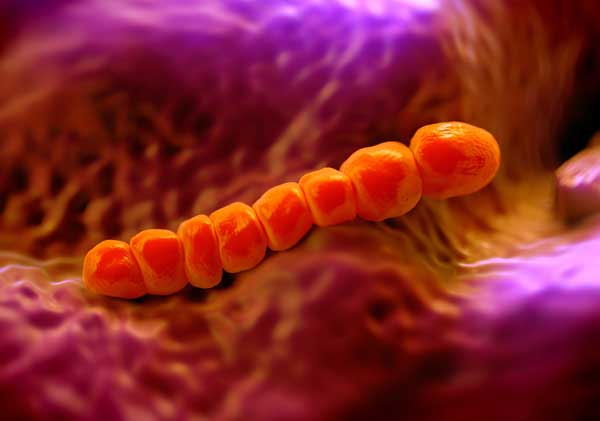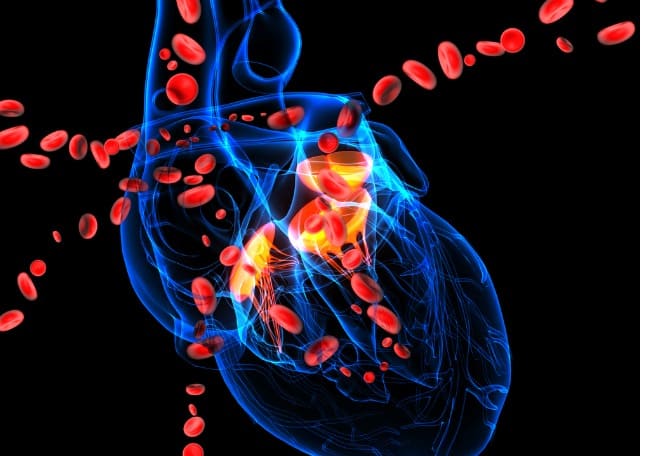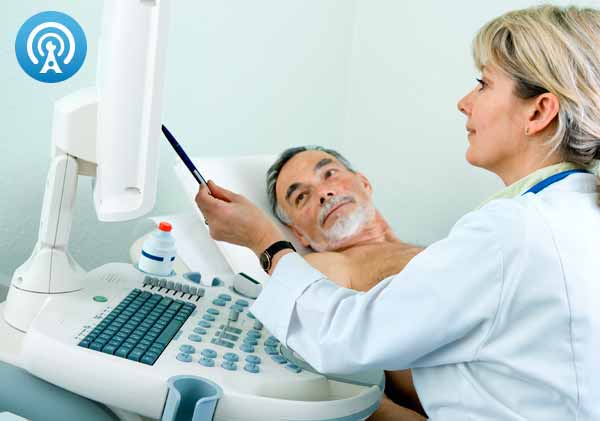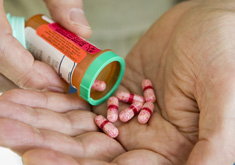Endocarditis infecciosa en adultos (Parte 2)

73. LaPlante KL, Rybak MJ. Impact of high-inoculum Staphylococcus aureus on the activities of nafcillin, vancomycin, linezolid, and daptomycin, alone and in combination with gentamicin, in an in vitro pharmacody-namic model. Antimicrob Agents Chemother. 2004; 48:4665–4672. doi: 10.1128/AAC.48.12.4665-4672.2004.
74. Arhin FF, Sarmiento I, Parr TR Jr, Moeck G. Activity of oritavancin and comparators in vitro against standard and high inocula of Staphylococcus aureus. Int J Antimicrob Agents. 2012; 39:159–162. doi: 10.1016/j. ijantimicag.2011.09.017.
75. Rose WE, Leonard SN, Rossi KL, Kaatz GW, Rybak MJ. Impact of inoculum
size and heterogeneous vancomycin-intermediate Staphylococcus aureus (hVISA) on vancomycin activity and emergence of VISA in an in vitro pharmacodynamic model. Antimicrob Agents Chemother. 2009;53:805–807. doi: 10.1128/AAC.01009-08.
76. Eagle H. The effect of the size of the inoculum and the age of the infection on the curative dose of penicillin in experimental infections with streptococci, pneumococci, and Treponema pallidum. J Exp Med. 1949; 90:595–607.
77. Lunde CS, Rexer CH, Hartouni SR, Axt S, Benton BM. Fluorescence microscopy demonstrates enhanced targeting of telavancin to the division septum of Staphylococcus aureus. Antimicrob Agents Chemother. 2010; 54:2198–2200. doi: 10.1128/AAC.01609-09.
78. Pogliano J, Pogliano N, Silverman JA. Daptomycin-mediated reorganization of membrane architecture causes mislocalization of essential cell division proteins. J Bacteriol. 2012; 194:4494–4504. doi: 10.1128/ JB.00011-12.
79. Eng RH, Padberg FT, Smith SM, Tan EN, Cherubin CE. Bactericidal effects of antibiotics on slowly growing and nongrowing bacteria. Antimicrob Agents Chemother. 1991; 35:1824–1828.
80. Stevens DL, Yan S, Bryant AE. Penicillin-binding protein expression at different growth stages determines penicillin efficacy in vitro and in vivo: an explanation for the inoculum effect. J Infect Dis. 1993; 167:1401–1405.
81. LaPlante KL, Woodmansee S. Activities of daptomycin and vancomycin alone and in combination with rifampin and gentamicin against biofilm-forming methicillin-resistant Staphylococcus aureus isolates in an experimental model of endocarditis. Antimicrob Agents Chemother. 2009;53:3880–3886. doi: 10.1128/AAC.00134-09.
82. Mizunaga S, Kamiyama T, Fukuda Y, Takahata M, Mitsuyama J. Influence of inoculum size of Staphylococcus aureus and Pseudomonas aeruginosa on in vitro activities and in vivo efficacy of fluoroquinolones and carbapenems. J Antimicrob Chemother. 2005; 56:91–96. doi: 10.1093/jac/dki163.
83. Murray BE, Church DA, Wanger A, Zscheck K, Levison ME, Ingerman MJ, Abrutyn E, Mederski-Samoraj B. Comparison of two beta-lactamase- producing strains of Streptococcus faecalis. Antimicrob Agents Chemother. 1986; 30:861–864.
84. Sabath LD, Garner C, Wilcox C, Finland M. Effect of inoculum and of beta-lactamase on the anti-staphylococcal activity of thirteen penicillins and cephalosporins. Antimicrob Agents Chemother. 1975; 8:344–349.
85. Johnson CC, Livornese L, Gold MJ, Pitsakis PG, Taylor S, Levison ME. Activity of cefepime against ceftazidime-resistant Gram-negative bacilli using low and high inocula. J Antimicrob Chemother. 1995; 35:765–773.
86. Bayer AS, Hirano L, Yih J. Development of beta-lactam resistance and increased quinolone MICs during therapy of experimental Pseudomonas aeruginosa endocarditis. Antimicrob Agents Chemother. 1988;32:231–235.
87. Ingerman M, Pitsakis PG, Rosenberg A, Hessen MT, Abrutyn E, Murray BE, Levison ME. Beta-lactamase production in experimental endocarditis due to aminoglycoside-resistant Streptococcus faecalis. J Infect Dis. 1987; 155:1226–1232.
88. Jimenez-Lucho VE, Saravolatz LD, Medeiros AA, Pohlod D. Failure of therapy in pseudomonas endocarditis: selection of resistant mutants. J Infect Dis. 1986; 154:64–68.
89. Hunter TH. Speculations on the mechanism of cure of bacterial endocarditis. J Am Med Assoc. 1950; 144:524–527.
90. Francioli P, Ruch W, Stamboulian D. Treatment of streptococcal endocarditis with a single daily dose of ceftriaxone and netilmicin for 14 days: a prospective multicenter study. Clin Infect Dis. 1995; 21:1406–1410.
91. Chambers HF, Miller RT, Newman MD. Right-sided Staphylococcus aureus endocarditis in intravenous drug abusers: two-week combination therapy. Ann Intern Med. 1988; 109:619–624.
92. Ribera E, Gómez-Jimenez J, Cortes E, del Valle O, Planes A, Gonzalez- Alujas T, Almirante B, Ocaña I, Pahissa A. Effectiveness of cloxacillin with and without gentamicin in short-term therapy for right-sided Staphylococcus aureus endocarditis: a randomized, controlled trial. Ann Intern Med. 1996; 125:969–974.
93. Bayer AS, Cheng D, Yeaman MR, Corey GR, McClelland RS, Harrel LJ, Fowler VG Jr. In vitro resistance to thrombin-induced platelet microbicidal protein among clinical bacteremic isolates of Staphylococcus aureus correlates with an endovascular infectious source. Antimicrob Agents Chemother. 1998; 42:3169–3172.
94. Carbon C, Crémieux AC, Fantin B. Pharmacokinetic and pharmacodynamic aspects of therapy of experimental endocarditis. Infect Dis Clin North Am. 1993; 7:37–51.
95. Cremieux AC, Maziere B, Vallois JM, Ottaviani M, Azancot A, Raffoul H, Bouvet A, Pocidalo JJ, Carbon C. Evaluation of antibiotic diffusion into cardiac vegetations by quantitative autoradiography. J Infect Dis. 1989; 159:938–944.
96. Crémieux AC, Mazière B, Vallois JM, Ottaviani M, Bouvet A, Pocidalo JJ, Carbon C. Ceftriaxone diffusion into cardiac fibrin vegetation: qualitative and quantitative evaluation by autoradiography. Fundam Clin Pharmacol. 1991; 5:53–60.
97. Cremieux AC, Saleh-Mghir A, Vallois JM, Maziere B, Muffat-Joly M, Devine C, Bouvet A, Pocidalo JJ, Carbon C. Efficacy of temafloxacin in experimental Streptococcus adjacens endocarditis and autoradiographic diffusion pattern of [14C]temafloxacin in cardiac vegetations. Antimicrob Agents Chemother. 1992; 36:2216–2221.
98. Fantin B, Leclercq R, Ottaviani M, Vallois JM, Maziere B, Duval J, Pocidalo JJ, Carbon C. In vivo activities and penetration of the two components of the streptogramin RP 59500 in cardiac vegetations of experimental endocarditis. Antimicrob Agents Chemother. 1994; 38:432–437.
99. Mertes PM, Jehl F, Burtin P, Dopff C, Pinelli G, Villemot JP, Monteil H, Dureux JB. Penetration of ofloxacin into heart valves, myocardium, mediastinal fat, and sternal bone marrow in humans. Antimicrob Agents Chemother. 1992; 36:2493–2496.
100. Nicolau DP, Freeman CD, Nightingale CH, Coe CJ, Quintiliani R. Minocycline versus vancomycin for treatment of experimental endocarditis caused by oxacillin-resistant Staphylococcus aureus. Antimicrob Agents Chemother. 1994; 38:1515–1518.
101. Rybak MJ. Pharmacodynamics: relation to antimicrobial resistance. Am J Med. 2006;119(suppl 1):S37–S44. doi: 10.1016/j.amjmed.2006.04.001.
102. Drusano GL. Antimicrobial pharmacodynamics: critical interactions of “bug and drug.” Nat Rev Microbiol. 2004;2:289–300. doi: 10.1038/ nrmicro862.
103. Craig WA. Pharmacokinetic/pharmacodynamic parameters: rationale for antibacterial dosing of mice and men. Clin Infect Dis. 1998; 26:1–10; quiz 11–12.
104. Forrest A, Nix DE, Ballow CH, Goss TF, Birmingham MC, Schentag JJ. Pharmacodynamics of intravenous ciprofloxacin in seriously ill patients. Antimicrob Agents Chemother. 1993; 37:1073–1081.
105. Hughes DW, Frei CR, Maxwell PR, Green K, Patterson JE, Crawford GE, Lewis JS 2nd. Continuous versus intermittent infusion of oxacillin for treatment of infective endocarditis caused by methicillin-susceptible Staphylococcus aureus. Antimicrob Agents Chemother. 2009; 53:2014–2019. doi: 10.1128/AAC.01232-08.
106. Li J, Echevarria KL, Hughes DW, Cadena JA, Bowling JE, Lewis JS 2nd. Comparison of cefazolin versus oxacillin for treatment of complicated bacteremia caused by methicillin-susceptible Staphylococcus aureus. Antimicrob Agents Chemother. 2014; 58:5117–5124. doi: 10.1128/AAC.02800-14.
107. Kashuba AD, Nafziger AN, Drusano GL, Bertino JS Jr. Optimizing aminoglycoside therapy for nosocomial pneumonia caused by Gramnegative bacteria. Antimicrob Agents Chemother. 1999; 43:623–629.
108. Louie A, Kaw P, Liu W, Jumbe N, Miller MH, Drusano GL. Pharmacodynamics of daptomycin in a murine thigh model of Staphylococcus aureus infection. Antimicrob Agents Chemother. 2001;45:845–851. doi: 10.1128/AAC.45.3.845-851.2001.
109. Liu C, Bayer A, Cosgrove SE, Daum RS, Fridkin SK, Gorwitz RJ, Kaplan SL, Karchmer AW, Levine DP, Murray BE, Rybak MJ, Talan DA, Chambers HF. Clinical practice guidelines by the Infectious Diseases Society of America for the treatment of methicillin-resistant Staphylococcus aureus infections in adults and children: executive summary. Clin Infect Dis. 2011; 52:285–292. doi: 10.1093/cid/cir034.
110. Rose WE, Leonard SN, Sakoulas G, Kaatz GW, Zervos MJ, Sheth A, Carpenter CF, Rybak MJ. Daptomycin activity against Staphylococcus aureus following vancomycin exposure in an in vitro pharmacodynamic model with simulated endocardial vegetations. Antimicrob Agents Chemother. 2008; 52:831–836. doi: 10.1128/AAC.00869-07.
111. Chambers HF, Basuino L, Diep BA, Steenbergen J, Zhang S, Tattevin P, Alder J. Relationship between susceptibility to daptomycin in vitro and activity in vivo in a rabbit model of aortic valve endocarditis. Antimicrob Agents Chemother. 2009; 53:1463–1467. doi: 10.1128/AAC.01307-08.
112. Rybak M, Lomaestro B, Rotschafer JC, Moellering R Jr, Craig W, Billeter M, Dalovisio JR, Levine DP. Therapeutic monitoring of vancomycin in adult patients: a consensus review of the American Society of Health-System Pharmacists, the Infectious Diseases Society of America, and the Society of Infectious Diseases Pharmacists [published correction appears in Am J Health Syst Pharm. 2009; 66:887]. Am J Health Syst Pharm. 2009; 66:82–98. doi: 10.2146/ajhp080434.
113. Kullar R, Davis SL, Levine DP, Rybak MJ. Impact of vancomycin exposure on outcomes in patients with methicillin-resistant Staphylococcus aureus bacteremia: support for consensus guidelines suggested targets. Clin Infect Dis. 2011; 52:975–981. doi: 10.1093/cid/cir124.
114. Bai AD, Showler A, Burry L, Steinberg M, Ricciuto DR, Fernandes T, Chiu A, Raybardhan S, Science M, Fernando E, Tomlinson G, Bell CM, Morris AM. Impact of infectious disease consultation on quality of care, mortality, and length of stay in Staphylococcus aureus bacteremia: results from a large multicenter cohort study. Clin Infect Dis. 2015; 60:1451–1461. doi: 10.1093/cid/civ120.
115. Yamamoto S, Hosokawa N, Sogi M, Inakaku M, Imoto K, Ohji G, Doi A, Iwabuchi S, Iwata K. Impact of infectious diseases service consultation on diagnosis of infective endocarditis. Scand J Infect Dis. 2012;44:270– 275. doi: 10.3109/00365548.2011.638317.
116. Morris AJ, Drinković D, Pottumarthy S, MacCulloch D, Kerr AR, West T. Bacteriological outcome after valve surgery for active infective endocarditis: implications for duration of treatment after surgery. Clin Infect Dis. 2005; 41:187–194. doi: 10.1086/430908.
117. Muñoz P, Giannella M, Scoti F, Predomingo M, Puga D, Pinto A, Roda J, Marin M, Bouza E; Group for the Management of Infective Endocarditis of the Gregorio Marañón Hospital (GAME). Two weeks of postsurgical therapy may be enough for high-risk cases of endocarditis caused by Streptococcus viridans or Streptococcus bovis. Clin Microbiol Infect. 2012;18:293–299. doi: 10.1111/j.1469-0691.2011.03594.x.
118. Francioli P, Etienne J, Hoigné R, Thys JP, Gerber A. Treatment of streptococcal
endocarditis with a single daily dose of ceftriaxone sodium for 4 weeks: efficacy and outpatient treatment feasibility. JAMA. 1992; 267:264–267.
119. Wilson WR. Ceftriaxone sodium therapy of penicillin G-susceptible streptococcal endocarditis. JAMA. 1992; 267:279–280.
120. Sexton DJ, Tenenbaum MJ, Wilson WR, Steckelberg JM, Tice AD, Gilbert D, Dismukes W, Drew RH, Durack DT. Ceftriaxone once daily for four weeks compared with ceftriaxone plus gentamicin once daily for two weeks for treatment of endocarditis due to penicillin-susceptible streptococci: Endocarditis Treatment Consortium Group. Clin Infect Dis. 1998; 27:1470–1474.
121. Francioli PB. Ceftriaxone and outpatient treatment of infective endocarditis. Infect Dis Clin North Am. 1993; 7:97–115.
122. Bickford CL, Spencer AP. Biliary sludge and hyperbilirubinemia associated with ceftriaxone in an adult: case report and review of the literature. Pharmacotherapy. 2005; 25:1389–1395. doi: 10.1592/phco.2005.25.10.1389.
123. Prabhu RM, Piper KE, Baddour LM, Steckelberg JM, Wilson WR, Patel R. Antimicrobial susceptibility patterns among viridans group streptococcal isolates from infective endocarditis patients from 1971 to 1986 and 1994 to 2002. Antimicrob Agents Chemother. 2004; 48:4463–4465. doi: 10.1128/AAC.48.11.4463-4465.2004.
124. Knoll B, Tleyjeh IM, Steckelberg JM, Wilson WR, Baddour LM. Infective endocarditis due to penicillin-resistant viridans group streptococci. Clin Infect Dis. 2007; 44:1585–1592. doi: 10.1086/518174.
125. Shelburne SA 3rd, Greenberg SB, Aslam S, Tweardy DJ. Successful ceftriaxone therapy of endocarditis due to penicillin non-susceptible viridans streptococci. J Infect. 2007; 54:e99–e101. doi: 10.1016/j. jinf.2006.05.010.
126. Fujitani S, Rowlinson MC, George WL. Penicillin G-resistant viridians group streptococcal endocarditis and interpretation of the American Heart Association’s guidelines for the treatment of infective endocarditis. Clin Infect Dis. 2008; 46:1064–1066. doi: 10.1086/529199.
127. Roberts R. Streptococcal endocarditis: the viridans and beta-hemolytic streptococci. In: Kaye D, ed. Infective Endocarditis. New York, NY: Raven Press; 1992:191–208.
128. Bouvet A, Cremieux AC, Contrepois A, Vallois JM, Lamesch C, Carbon C. Comparison of penicillin and vancomycin, individually and in combination with gentamicin and amikacin, in the treatment of experimental endocarditis induced by nutritionally variant streptococci. Antimicrob Agents Chemother. 1985; 28:607–611.
129. Lefort A, Mainardi JL, Selton-Suty C, Casassus P, Guillevin L, Lortholary O. Streptococcus pneumoniae endocarditis in adults: a multicenter study in France in the era of penicillin resistance (1991-1998): the Pneumococcal Endocarditis Study Group. Medicine (Baltimore). 2000;79:327–337.
130. Yu VL, Chiou CC, Feldman C, Ortqvist A, Rello J, Morris AJ, Baddour LM, Luna CM, Snydman DR, Ip M, Ko WC, Chedid MB, Andremont A, Klugman KP; International Pneumococcal Study Group. An international prospective study of pneumococcal bacteremia: correlation with in vitro resistance, antibiotics administered, and clinical outcome. Clin Infect Dis. 2003; 37:230–237. doi: 10.1086/377534.
131. Martínez E, Miró JM, Almirante B, Aguado JM, Fernandez-Viladrich P, Fernandez-Guerrero ML, Villanueva JL, Dronda F, Moreno-Torrico A, Montejo M, Llinares P, Gatell JM; Spanish Pneumococcal Endocarditis Study Group. Effect of penicillin resistance of Streptococcus pneumonia on the presentation, prognosis, and treatment of neumococcal endocarditis in adults. Clin Infect Dis. 2002; 35:130–139. doi:
10.1086/341024.
132. Smyth EG, Pallett AP, Davidson RN. Group G streptococcal endocarditis:
two case reports, a review of the literature and recommendations for treatment. J Infect. 1988; 16:169–176.
133. Baddour LM. Infective endocarditis caused by beta-hemolytic streptococci:
the Infectious Diseases Society of America’s Emerging Infections Network. Clin Infect Dis. 1998; 26:66–71.
134. Lefort A, Lortholary O, Casassus P, Selton-Suty C, Guillevin L, Mainardi JL; β-Hemolytic Streptococci Infective Endocarditis Study Group. Comparison between adult endocarditis due to beta-hemolytic streptococci (serogroups A, B, C, and G) and Streptococcus milleri: a multicenter study in France. Arch Intern Med. 2002; 162:2450–2456.
135. Sambola A, Miro JM, Tornos MP, Almirante B, Moreno-Torrico A, Gurgui M, Martinez E, Del Rio A, Azqueta M, Marco
Comentarios
Para ver los comentarios de sus colegas o para expresar su opinión debe ingresar con su cuenta de IntraMed.










